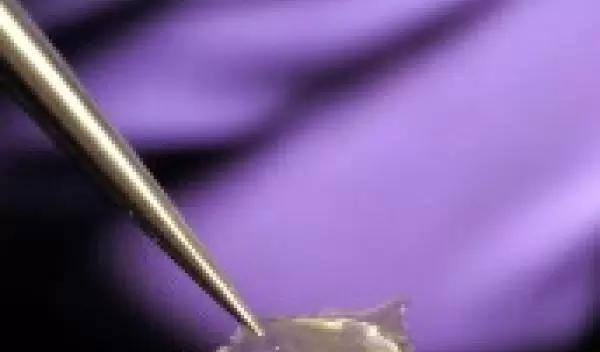
Modified Collagen Could Be a Boon for Medicine
Collagen, a naturally occurring protein already famous for its ability to plump up lips and fill in smile lines, may soon be playing a more substantial role in medicine. Materials scientists at Johns Hopkins have discovered an easy way to modify collagen into forms that could block the formation of unwanted scar tissue, control the growth of tiny new blood vessels in tissues destined for implantation, and even lead to better infection-fighting bandages.
Johns Hopkins engineer Michael (Seungju) Yu described the new collagen modification process and its potential medical uses on Aug. 30, in a presentation at the 230th annual meeting of the American Chemical Society in Washington, D.C. Yu and his colleagues also published a paper on the work earlier this year in the Journal of the American Chemical Society.
In its natural state, Yu explained, collagen promotes blood clotting and provides the sponge-like scaffold upon which cells build nerves, bones and skin. Indeed, it is the most common protein in the body. Moreover, it is nontoxic, dissolves naturally over time and rarely triggers rejection—properties that have led to its widespread use in cosmetics, drug delivery systems and biocompatible coatings.
Unfortunately, Yu added, practical applications of collagen often require that scientists tweak its biochemical or mechanical properties. And when done by traditional techniques, that can end up damaging the protein or limiting its safe use in humans. That's why he and his colleagues have pioneered a gentler method in which the collagen molecules are decorated with smaller compounds known as collagen mimetic peptides.
"That's the beauty of this," said Yu. "If you want to attach these molecules to collagen, you don't have to cook it or use harsh chemicals. You just mix them together in a solution."
In lab experiments, Yu and his colleagues have shown that this kind of molecular marriage does take place. They attached fluorescent tags to the peptides and observed the glow in collagen that had been mixed with the smaller molecules. Exactly how and why the collagen and the peptides join is uncertain. But researchers know collagen molecules form a distinctive triple helix in which three long protein strands intertwine like rope. Yu speculates that because the smaller collagen mimetic peptides have a propensity to make similar triple-helix structures, they are naturally attracted to collagen molecules. He believes the peptides make themselves at home within gaps formed by loose collagen strands.
This linking opens the door to new medical treatments, Yu says, because it is easy to attach bioactive agents to the peptides, which can dramatically change the way collagen behaves in the body. For example, collagen normally attracts cells to close up a wound and form scar tissue. But this property is not always desirable; a clot can be dangerous inside a blood vessel or at certain injury sites, where scar tissue can interfere with the formation of new nerve connections.
Modified collagen can follow a different course. In their recent journal paper, Yu and his colleagues reported they had attached a chemical, polyethylene glycol, to the peptides, causing collagen to repel cells instead of attracting them. When the researchers added human cells to a lab dish, the cells migrated toward an untreated collagen film but avoided the modified collagen sample. This form of collagen could stop the formation of blood clots and scar tissue, and scientists may be able to use it to control the shape and organization of cells and tissue that are grown in a lab, Yu says.
Still other medical uses are possible. A growth factor joined to collagen could encourage new cells to multiply. An antibiotic attached to collagen could help a collagen-based bandage fight infections over a long period of time. Modified collagen could also release helpful medications while serving as a coating for surgical tools and implants.
"With this process," Yu said, "we can make the collagen that's already found in the human body behave in new ways, including some ways that are not found in nature. Modified collagen can give us a great new tool for treating injuries and illnesses."
--Philip Sneiderman, Johns Hopkins University and M. Mitchell Waldrop, NSF


